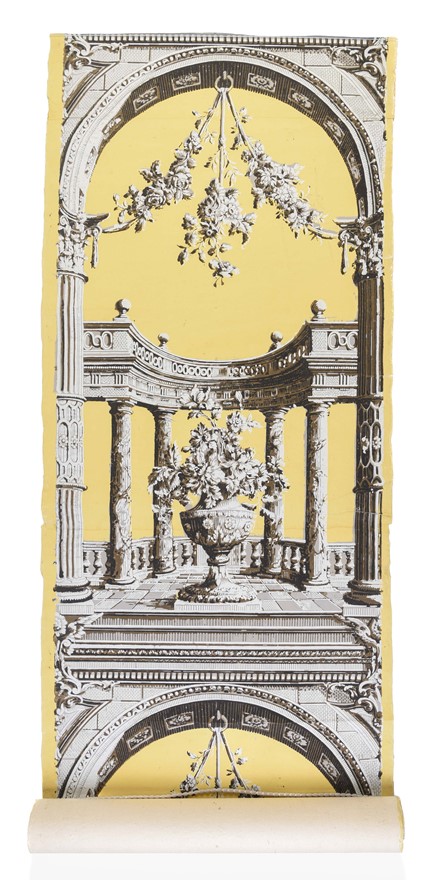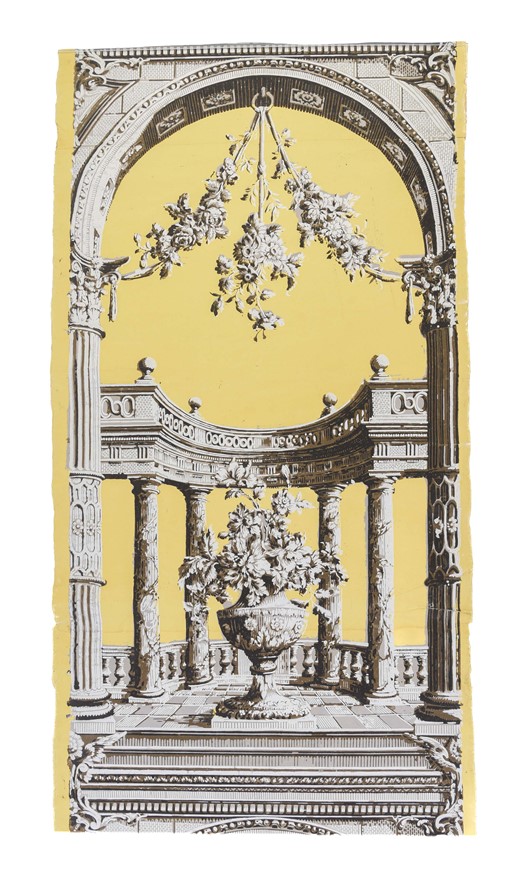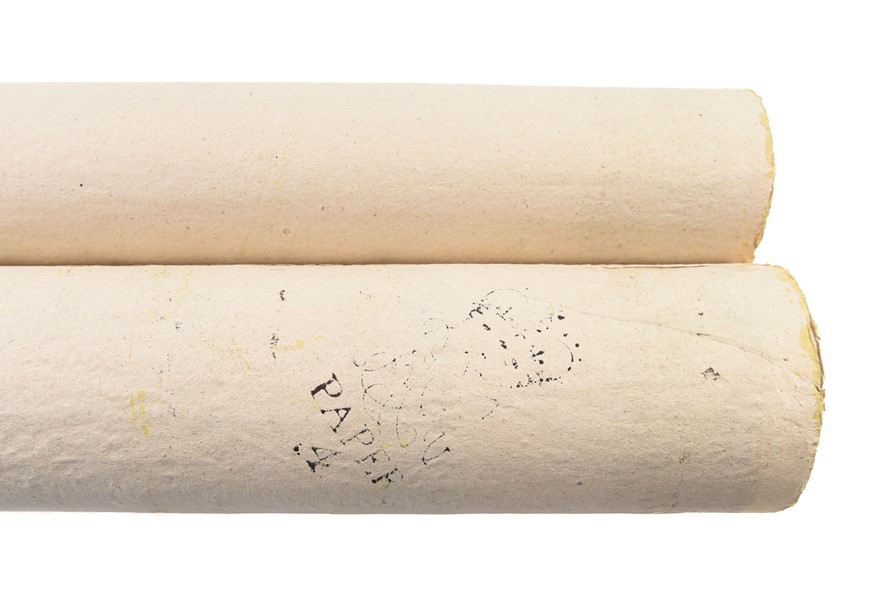A roll of eighteenth-century English wallpaper Left over from the 1769 decoration of the Old Manor, Bourton-on-the-Water, Gloucestershire.
WALLPAPER (c.1769])
£8500.00
“THE HIGHEST CLASS IN DESIGN AND EXECUTION”
A single roll of wallpaper. Over 3 meters in length and 575mm wide. Six sections of paper with a repeated architectural design incorporating Greek pillars with a vase of flowers in the foreground and festoons of flowers in the central arch, block-printed in four colours on a yellow ground. Tax stamps to the verso. In remarkably good condition.
[?London
Charles Oman, Wallpapers : an international history and illustrated survey from the Victoria and Albert Museum (1982) no.99. The V & A has a single section of this design acquired in 1926 from the same source (on display in the British Galleries) - E.964-1926
A roll of English wallpaper of "the highest class in design and execution" - unused and left over from the 1769 decoration of the Old Manor in Bourton-on-the-Water, Gloucestershire. A remarkable survival incorporating a classical architectural design against a vivid ("sheer delight") yellow ground. An unusual English design and more often found in American houses of this period.
"Several circumstances combined to make the 18th century a period that saw wallpaper take its assured place in domestic interior decoration. The progress made in the manufacture of paper during the reigns of the Stuarts, the rapid spread of material wealth among the trading, as well as the land-owning classes, the national instinct towards a mode of living removed alike from the the austerities of the Puritan period and from the libertinism of the Courts of Charles II and James II, and the stimulus given to artistic taste by contact with the treasures of the Far East, all played their part in bringing wallpaper into common use. And yet not too common for the famous diarists and letter-writers of the period to ignore it. Indeed, it is from some of these entreating gossips, such as Horace Walpole, the poet Gray, Mrs. Delany, Mrs. Montagu, and Mrs. Powys, that we draw on most vivid impressions of the importance wallpapers attained in the domestic amenities of the time" (Alan Victor Sugden & John Ludlam Edmondson, A History of English Wallpaper 1509-1914 p.41).
Sugden and Edmondson describe this wallpaper as preserving the "original freshness in texture and colour in a remarkable manner" noting that the present example is a "striking" design where "the clever effect obtained by means so simple as the quiet tones of the detail against the yellow background testifies to the possession of high artistic sense on the part of the producer". The design had originally been attributed to the paper maker Jackson but Sugden and Edmondson note this is unlikely but it certainly is English (proved by the G.R Excise stamps on the blank verso of the sheets) and, "in all probability came from one of the leading paper-stainers of the period; as good a guess as any would be Bromwich, of Ludgate Hill, or Spinnage, of Cockspur Street." (p.68-9)
"Until the late 18th century, London was the centre of the wallpaper trade. Wallpapers manufactured in London were sold throughout the country, and exported to France and other parts of Continental Europe. From the 1750s English wallpapers were also sent out to America. In 1754 a Boston newspaper advertised 'Printed Paper for Rooms lately imported from London'. The pillar and arch style of wallpaper decoration was particularly popular in America. English wallpapers fell out of favour after the War of Independence (1776-1783), when America severed its political links with Britain, and American customers began to prefer French styles. At the same time an American wallpaper industry was being established."
"Pillar and arch pattern wallpapers were not widely used in Britain, but this unused piece was left over from the re-decoration in 1769 of the Manor House at Bourton-on-the-Water, Gloucestershire. Similar patterns survive in a number of American houses. This particular design has been reproduced specifically for the refurbishment of an historic house museum - Gunston Hall, in Lorton, Virginia - where it has been hung in the entrance hall. In the 18th and 19th centuries most makers and sellers of paper-hangings (as wallpapers were then called) specified that the bold design of pillar and arch patterns were best suited to halls and stair-wells." (from the V&A catalogue).
The Manor House was most likely redecorated by William Snooke (d. 1793) shortly after his 2nd marriage to Anne Snooke (licensed 4th June 1767). His unpublished diaries for 1768, 1769, 1774, 1775 are in Gloucestershire Record Office (R.O.L. G3)
Provenance: Surviving examples are left over from the redecoration of the Old Manor House in 1769 and passed to Mrs. Mary Gladys Waller (Stenson) Simpson-Hayward (1881-1955), of nearby Icomb Manor, near Stow-on-the-Wold, daughter of William Snooke Stenson (1817-88) and granddaughter of Nathaniel Stenson and Eliza Snooke.
Stock Code: 249731






